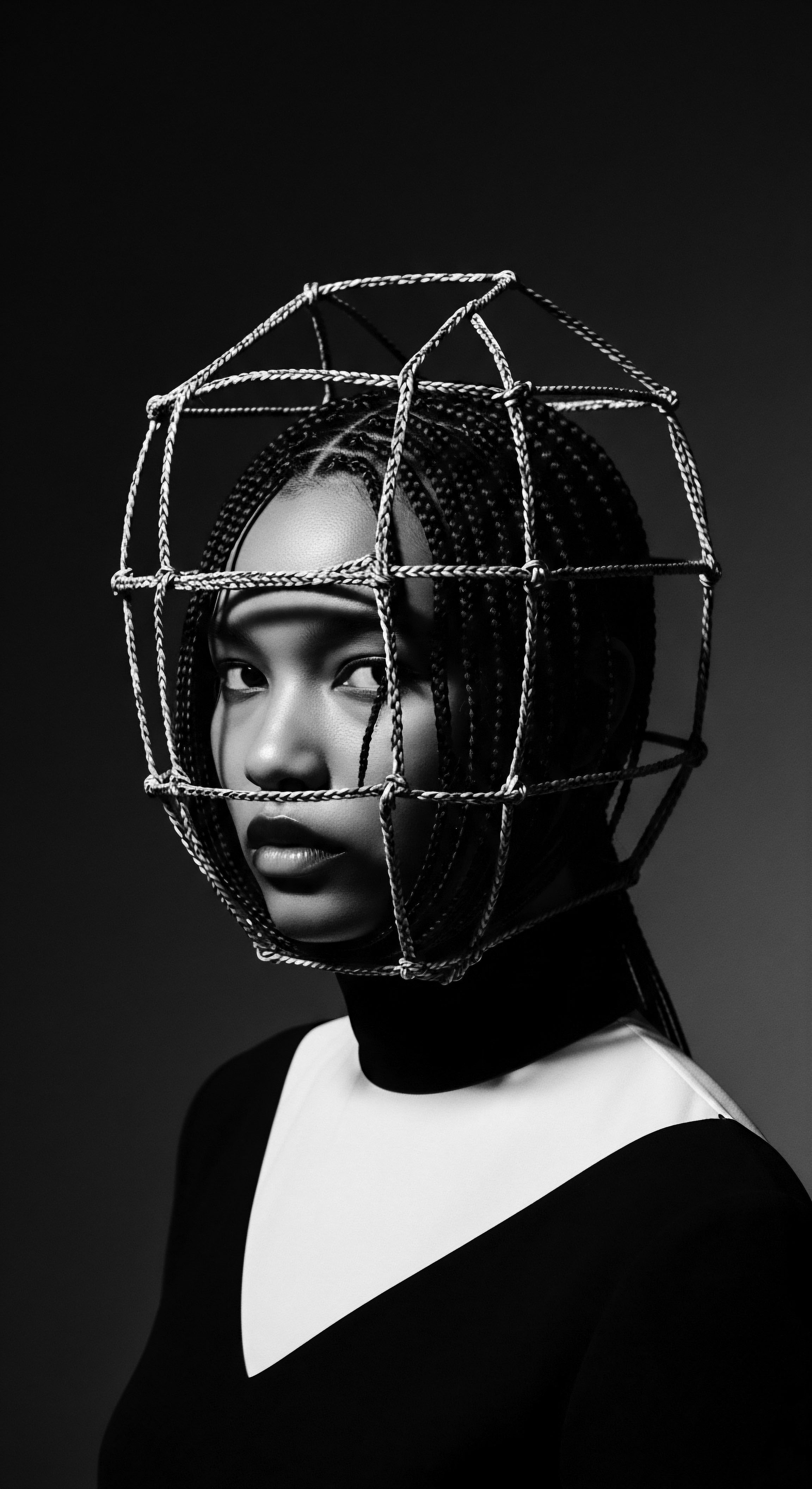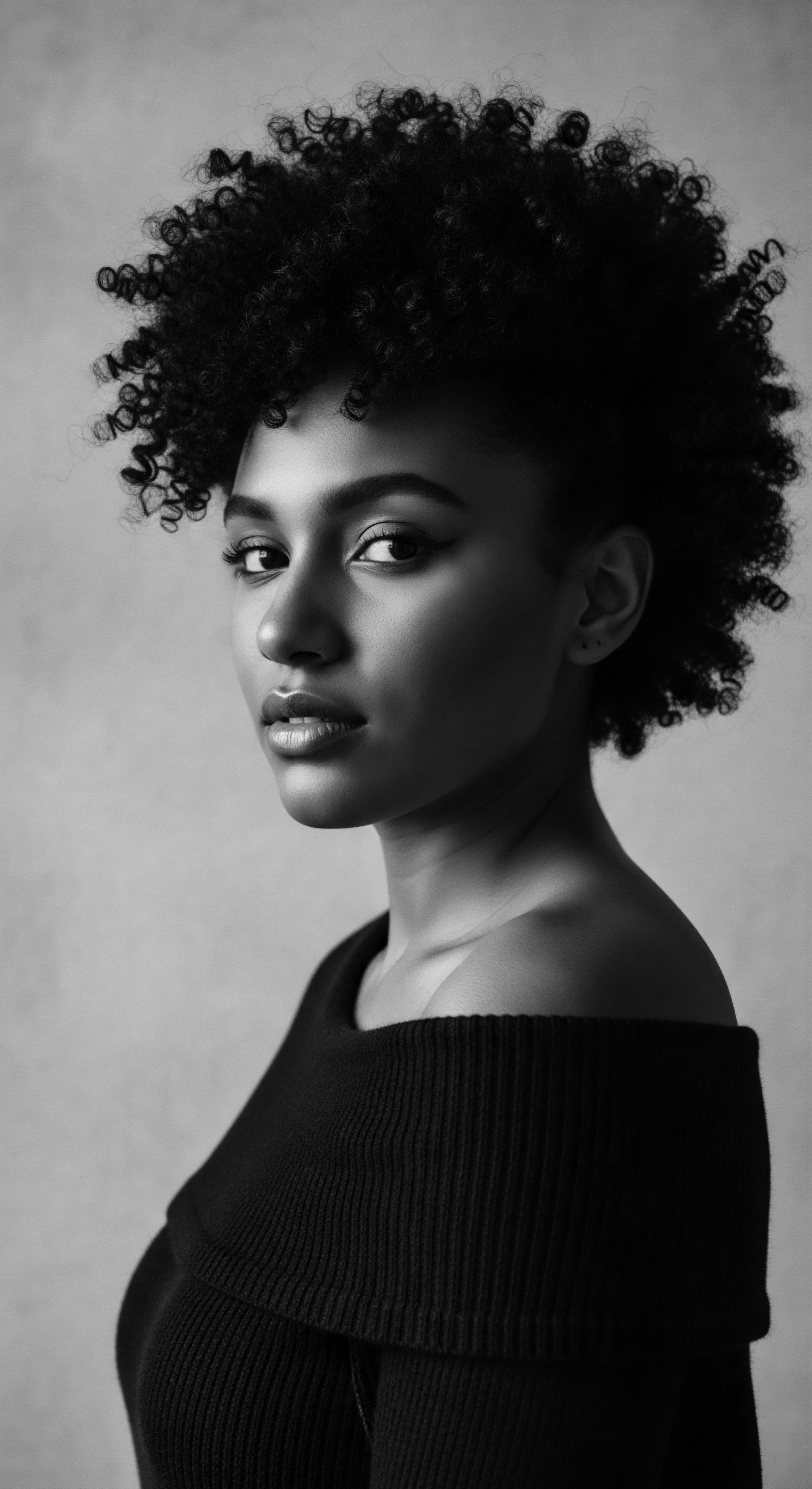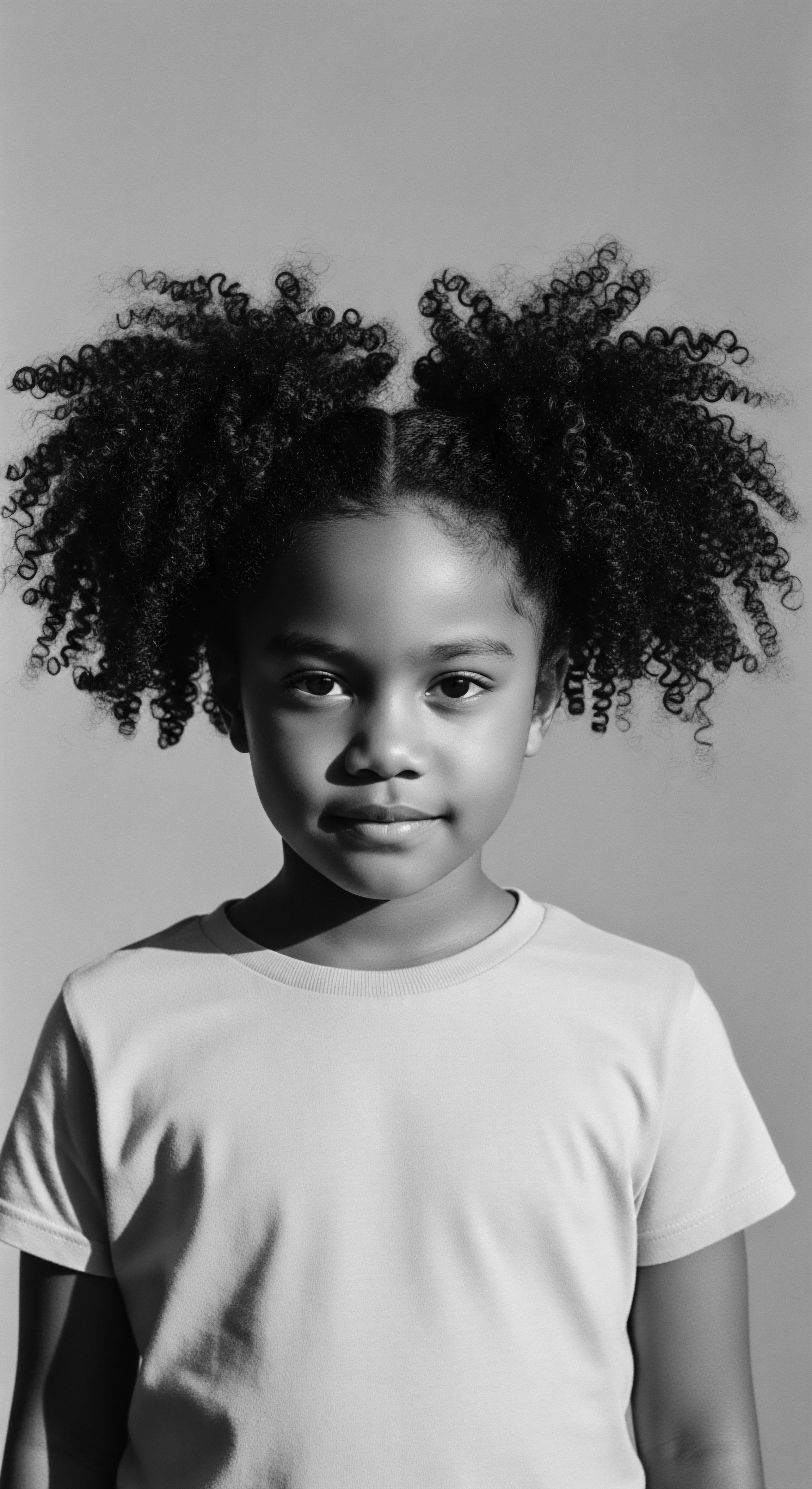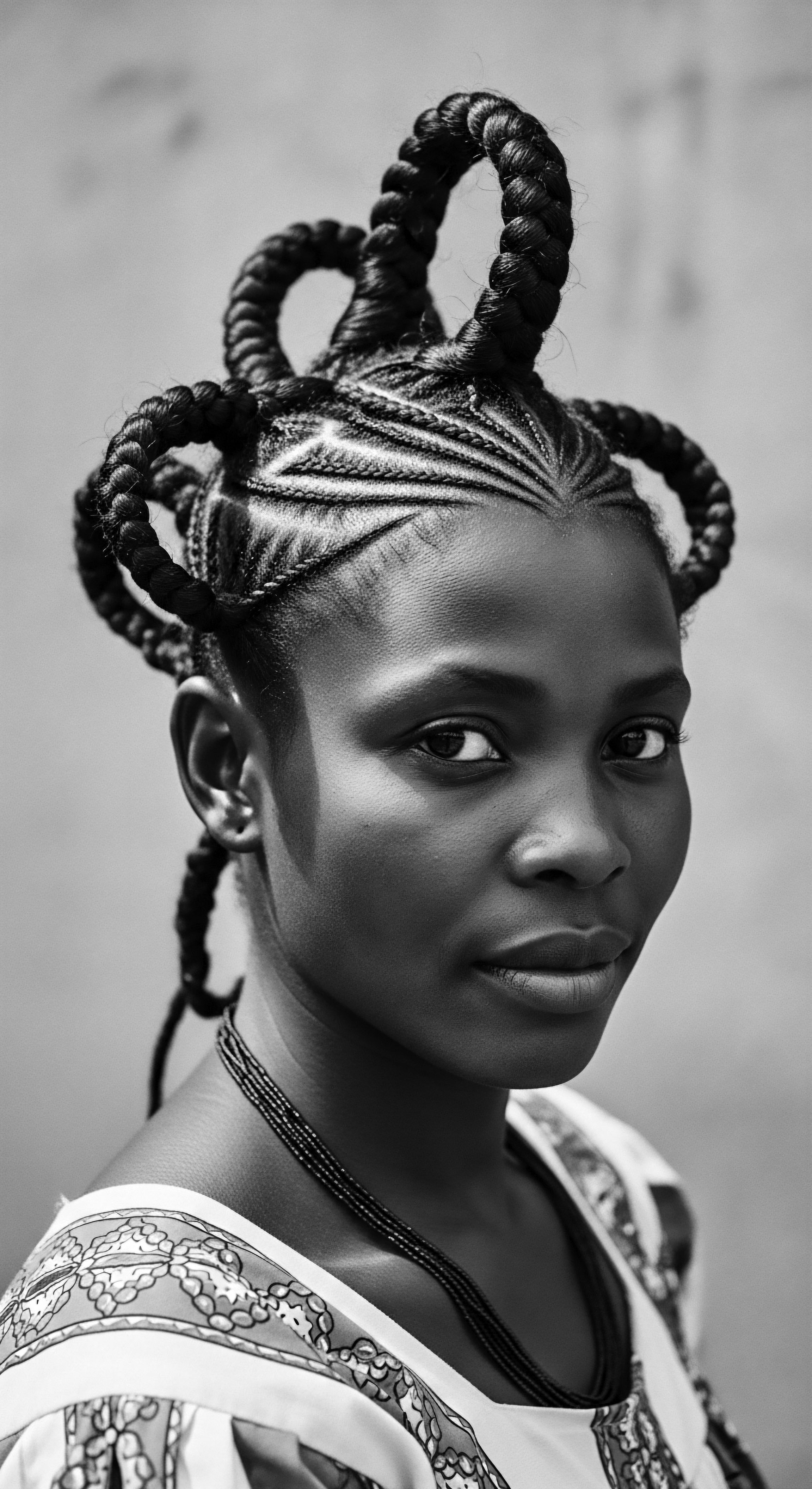
Fundamentals
Within the vast realm of natural phenomena, the concept of thermal energy stands as a fundamental force, orchestrating the very dance of atoms and molecules. Its most straightforward explanation, suitable for those beginning a deeper understanding, defines thermal energy as the internal energy of a system, directly responsible for its temperature. This energy arises from the collective movement, whether translational, rotational, or vibrational, of a substance’s constituent particles.
When warmth enters a substance, these particles quicken their pace, causing them to collide more frequently and with greater force, thus elevating the temperature of the material. The greater the kinetic energy of these particles, the higher the thermal energy present.
Consider a familiar scenario ❉ a pot of water placed upon a warm hearth. As the flame flickers beneath, the water molecules begin to jiggle and shift with increased vigor. This burgeoning activity signifies an accumulation of thermal energy within the water, translating into a noticeable rise in its temperature. That perceptible sensation of heat is, in fact, the movement of this thermal energy.
It is a form of kinetic energy at the molecular scale, a vibrant, ceaseless motion even within what appears to be a motionless solid. Even at thermal equilibrium, particles continue their motion, though without a net transfer of energy.
The understanding of thermal energy, its definition, and its subtle workings reaches far beyond the boundaries of traditional physics classrooms; it finds profound resonance in the lived experiences and ancestral practices surrounding textured hair.

The Dance of Molecules ❉ A Simple Elucidation
At its simplest, thermal energy can be viewed as the sum of all the kinetic energy possessed by the microscopic particles within any given object. Every speck of matter, from the smallest dust mote to the grandest mountain, holds within it these endlessly moving particles. When we introduce warmth, we are, in essence, supplying these particles with more energy, causing them to move with greater intensity. This intensification manifests as a rise in the object’s temperature.
- Conduction ❉ In the context of solid objects, such as a heated metal comb, thermal energy travels from one molecule to its neighbor through vibrations. The molecules remain in their fixed positions, yet their energetic jiggling effectively transmits warmth across the material.
- Convection ❉ This method involves the movement of heated fluids, like the warm air currents from a blow dryer. The warmer, less dense air rises, carrying its thermal energy, while cooler air descends, creating a circulating pattern that distributes warmth.
- Radiation ❉ Warmth can also spread through electromagnetic waves, like the sun’s gentle rays on hair. This transfer does not require direct contact or a medium.
This elemental understanding, rooted in physics, becomes an interpretive key for appreciating the intricate relationship between warmth and hair. Think of the sun’s benevolent touch drying freshly washed hair, a process relying on thermal energy. Or consider the traditional methods of drying hair by a hearth, where the subtle warmth assisted in preparing strands for styling. Such fundamental comprehension offers a gateway to exploring how warmth has always played a role in the care and shaping of textured hair across generations.
Thermal energy is the unseen dynamism within all matter, expressed as temperature, a collective dance of molecules influenced by warmth.
The recognition of thermal energy as a fundamental aspect of matter, therefore, extends beyond theoretical constructs. It speaks to the intuitive wisdom held by ancestors who understood, through observation and practice, how to harness warmth for practical purposes, even if they articulated its impact differently. The practical applications of this elemental force, from drying grains to shaping clay, mirrored the nascent understanding of its potential to influence material forms, including the unique structure of hair.

Intermediate
Expanding upon the foundational insight, an intermediate examination of thermal energy deepens our appreciation for its transformative capabilities, particularly as they relate to the intricate biological and structural aspects of textured hair. Thermal energy, at this level of interpretation, is not simply about temperature; it encompasses the quantity of internal energy within a system that can be transferred as heat, leading to changes in the physical and chemical state of matter. For hair, this translates into a delicate interplay with its very molecular scaffolding. The understanding of thermal energy’s significance, its meaning, and its direct link to hair’s malleability and resilience, becomes clearer when viewed through the lens of its impact on hydrogen and disulfide bonds.

Thermal Energy and Hair’s Molecular Architecture
Hair, a protein fiber, owes its unique form and strength to a complex arrangement of bonds. Two types of these bonds are particularly susceptible to the influence of thermal energy ❉ hydrogen bonds and disulfide bonds. Hydrogen bonds, which are numerous yet weak, are readily disrupted by both water and warmth. When strands are moistened, these bonds temporarily break, allowing the hair to become pliable.
As warmth is applied, such as during air drying or with a blow dryer, the water evaporates, and new hydrogen bonds reform, locking the hair into its new configuration until it encounters water again. This explains why a “press and curl” style, historically achieved with a heated comb, reverts once the hair becomes damp.
Disulfide bonds, in contrast, are much stronger and provide hair with its intrinsic shape, elasticity, and overall structural integrity. These covalent bonds are not easily broken by warmth alone; they require chemical intervention, such as that found in relaxers or perms, to be altered permanently. However, excessive or prolonged thermal exposure can still damage these robust bonds, leading to irreversible changes in hair’s structure and a loss of its natural curl pattern. This physical alteration of the protein structure is known as denaturation.
The ability of curly hair to trap air between its strands offers an insulating property, creating a natural buffer against environmental temperature changes. This characteristic, a remarkable adaptive feature, influences how thermal energy interacts with different curl patterns. Research endeavors, like those at Purdue University, are even exploring how warmth dissipates through various curl patterns to determine the optimal temperatures for thermal styling without incurring irreparable harm. Such studies help refine our definition of controlled warmth for hair’s well-being.
Thermal energy transforms hair through its influence on molecular bonds, particularly hydrogen bonds, which are the temporary architects of styling.

Ancestral Wisdom and the Control of Warmth
The practical understanding of thermal energy’s definition within the context of hair care finds its genesis in ancestral practices. Long before the advent of scientific instruments, communities across the African diaspora and indigenous cultures developed sophisticated methods for utilizing and managing warmth for their hair.
For instance, the use of warm oils for scalp massages, a practice still revered in many traditions, relies on the principle of thermal energy transfer. The gentle warmth of the oil, often heated over a low flame, allows for deeper penetration into the scalp and hair shaft, enhancing nourishment and elasticity. This historical knowledge of manipulating temperature, even subtly, showcases an innate grasp of thermal principles, often passed down through oral traditions and hands-on teaching within families.
Consider the drying of hair in direct sunlight or near a gentle fire. These seemingly simple acts demonstrate an intuitive engagement with radiant and convective thermal energy. The sun’s warmth, for example, would gently evaporate moisture, preparing hair for intricate braiding or styling. This careful approach to warmth, honed over centuries, underlines a deep respect for the hair’s integrity.
| Practice Sun Drying |
| Ancestral Context Gentle, natural evaporation for preparation and styling. |
| Modern Parallel / Scientific Link Low-heat blow drying; controlled air flow for minimal bond disruption. |
| Practice Heated Stones/Tools |
| Ancestral Context Used for temporary shaping, often in Native American traditions (heated wood/bone). |
| Modern Parallel / Scientific Link Modern flat irons, curling irons, though with vastly different temperature controls. |
| Practice Warm Oil Application |
| Ancestral Context Enhances penetration of nourishing ingredients into hair and scalp. |
| Modern Parallel / Scientific Link Warm deep conditioners, pre-poo treatments for enhanced absorption. |
| Practice These practices, separated by time, share a common thread ❉ the judicious application of warmth to influence hair's form and well-being. |
The legacy of these ancestral practices provides a powerful counter-narrative to the idea that thermal manipulation of hair is solely a modern invention or one driven purely by Eurocentric beauty standards. While later developments, like the hot comb, arose from complex societal pressures, the inherent concept of using warmth to shape hair has much older, culturally diverse roots.

Academic
From an academic vantage, the Thermal Energy Definition is the quantification of the total kinetic and potential energy associated with the random motion of atoms and molecules within a substance, manifesting as its measurable temperature. This collective internal energy, when transferred as heat, significantly influences the structural integrity and conformational possibilities of biological polymers such as hair keratin. A precise understanding of this definition, its implications, and its relationship to the unique biomechanical properties of textured hair, necessitates an interdisciplinary examination drawing upon physics, polymer chemistry, and cultural anthropology. The profound significance of warmth on hair structure becomes most evident when considering the delicate balance of hydrogen and disulfide bonds that collectively dictate curl pattern and resilience.

The Biomechanical Delineation of Thermal Impact on Hair
Hair, a complex biological fiber, is predominantly composed of keratin proteins, organized into intricate helical structures within the cortex, encased by protective cuticle scales. The macroscopic characteristics of textured hair – its coil, wave, and curl – are directly attributed to the distribution and arrangement of disulfide bonds, which are strong covalent linkages between cysteine amino acids. These bonds provide the hair’s lasting shape and inherent elasticity.
Adjacent to these robust connections are the more numerous, yet transient, hydrogen bonds, which form between polar groups on the keratin chains and water molecules. It is these hydrogen bonds that confer hair’s temporary malleability.
When thermal energy is applied to hair, its immediate and primary effect is the disruption of these weaker hydrogen bonds. As warmth increases the kinetic energy of water molecules, they vaporize, and the existing hydrogen bonds break. As the hair cools, and in the absence of moisture, new hydrogen bonds can reform, thereby stabilizing the hair in a new, temporarily altered configuration, such as a straightened state. This reversible process underpins the efficacy of styling techniques like blow-drying, hot combing, and flat ironing.
However, exceeding a critical thermal threshold leads to more severe and often irreversible structural changes. Temperatures surpassing approximately 200°C (392°F) can induce protein denaturation, a phenomenon where the keratin proteins within the hair’s cortex undergo conformational shifts, notably the transformation of the α-helix structure into a less organized β-sheet configuration. This protein degradation weakens the hair fiber, diminishing its strength and elasticity, and rendering it more susceptible to mechanical breakage.
Prolonged exposure to high heat can even initiate the breakdown of disulfide bridges, further compromising the hair’s permanent structure and leading to a significant, often irrecoverable, alteration of its natural curl pattern. Beyond structural damage, excessive thermal exposure can dehydrate the hair by rapidly evaporating bound water molecules and even alter hair lipids, leading to increased porosity and a dull appearance.
The kinetic and thermodynamic principles governing heat transfer in hair also differ based on curl typology. Studies, such as those conducted by Reid and Marconnet at Purdue University, suggest that the unique geometry of coiled hair may influence how heat dissipates from the strand, potentially requiring different temperature considerations for minimizing harm across diverse curl patterns. The inherent air-trapping capacity of highly textured hair contributes to its insulating properties, a detail with implications for both styling practices and natural thermoregulation. These intricate interactions underscore the necessity of a nuanced, scientifically grounded approach to thermal hair care, particularly for textured hair, which possesses distinct vulnerabilities and strengths.
- Hydrogen Bond Remodeling ❉ The foundational mechanism for temporary thermal styling, allowing hair to shift from a coiled to a straight configuration, then revert with moisture.
- Keratin Denaturation ❉ Irreversible structural damage to hair proteins when temperatures exceed safe limits (e.g. above 200°C), leading to a loss of elasticity and curl integrity.
- Disulfide Bond Breakdown ❉ While primarily chemically altered, prolonged extreme heat can also compromise these critical bonds, permanently impacting hair’s intrinsic shape and strength.

Sociocultural Dimensions and Ancestral Praxis
The definition of thermal energy, when considered within the heritage of textured hair, moves beyond mere scientific principles; it encompasses a complex sociocultural narrative. The application of warmth to hair is not a modern invention but a practice with deep historical roots, often entwined with identity, adaptation, and aesthetic expression.
In many African communities prior to the transatlantic slave trade, hair was a powerful marker of identity, marital status, age, and spiritual connection. Hair styling was a sophisticated art, involving practices that likely utilized natural thermal elements for drying and setting. While direct evidence of high-heat tools for texture alteration in ancient African traditions is less commonly documented than for ancient Egypt (where heated metal rods were used to straighten hair), the use of warmth for drying and setting intricate styles with natural butters and herbs was certainly a component of care rituals.
The concept of thermal styling took a fraught turn with the arrival of the hot comb in the 19th century. Although often credited to Madame C.J. Walker, its origins trace to French hairdresser Marcel Grateau in the 1870s, initially for European hair.
However, it was within the African American community that the hot comb gained widespread, complex significance. As societal pressures mounted for Black individuals to conform to Eurocentric beauty ideals, straightened hair became associated with acceptance and perceived advancement.
A powerful case study illuminating the Thermal Energy Definition’s intricate connection to textured hair heritage centers on the pervasive adoption of the hot comb in the early to mid-20th century. This tool, manually heated on stoves, offered a temporary means of straightening tightly coiled hair, influencing countless generations. Dr. Bernice Johnson Reagon, founder of the singing group Sweet Honey in the Rock, recounts the hot comb ritual as a significant rite of passage within African American communities.
Young girls would reach a certain age, often preparing for special occasions like Easter or significant church events, when they would experience their hair being “pressed” for the first time. This practice, performed often in the kitchen, involved the distinct smoky aroma of heated hair and the sizzling sound of the comb on a damp cloth, leaving indelible memories of self-presentation and communal care. This tradition, while rooted in the pragmatic application of thermal energy to hair, also reflects a deeper struggle with societal demands for assimilation and an enduring resilience in cultivating beauty amidst challenging circumstances.
The “press and curl” became a legendary style, facilitated by pioneering figures like Madame C.J. Walker, who, while not inventing the hot comb, popularized it and developed accompanying hair care products that made the process more accessible. This era saw the rise of a robust Black-owned beauty industry, creating entrepreneurial opportunities for Black women, even as it navigated the contentious terrain of Eurocentric beauty standards. The sociological implication is profound ❉ thermal energy, applied through this tool, became a medium through which identity was negotiated, expressed, and sometimes, constrained.
The narrative surrounding thermal hair practices is thus interwoven with themes of survival, adaptation, and the persistent assertion of selfhood. The more recent natural hair movement, spurred in part by social media and cultural awareness films, marked a deliberate shift away from chemical relaxers and often, from constant thermal styling, as Black individuals chose to embrace and celebrate their natural textures. This evolution reflects a re-evaluation of the relationship with thermal energy, moving towards protective measures and lower-heat options to preserve hair’s intrinsic health and curl pattern.
- 19th Century Origins ❉ The hot comb emerges, developed by Marcel Grateau, later adapted and popularized within African American communities.
- Early 20th Century ❉ Figures like Madame C.J. Walker build empires around thermal styling products and tools, making straightened hair more attainable and culturally significant.
- Mid-20th Century ❉ The “press and curl” solidifies its place as a staple style, often a marker of presentation for special occasions, deeply embedded in familial rituals.
- Late 20th/Early 21st Century ❉ A re-evaluation of thermal practices as the natural hair movement gains momentum, promoting textured hair acceptance and seeking alternative, low-heat styling.
| Era / Context Ancient African Traditions |
| Application of Thermal Energy Sun-drying, gentle warming for moisture management and style setting. |
| Cultural or Structural Implication Preservation of natural texture, cultural identity, spiritual connection. |
| Era / Context 19th-20th Century (Post-Slavery) |
| Application of Thermal Energy Hot comb for temporary hair straightening (e.g. the "press and curl"). |
| Cultural or Structural Implication Adaptation to Eurocentric beauty standards, economic opportunity (Madam C.J. Walker). |
| Era / Context Mid-20th Century |
| Application of Thermal Energy Continued use of hot combs and early electric irons for sleek styles. |
| Cultural or Structural Implication Symbol of respectability, familial bonding through hair rituals. |
| Era / Context 21st Century (Natural Hair Movement) |
| Application of Thermal Energy Reduced reliance on high heat, focus on heat protectants, lower-temperature tools for temporary styling. |
| Cultural or Structural Implication Celebration of natural texture, hair health advocacy, reclaiming agency over hair identity. |
| Era / Context The journey of thermal energy in textured hair care illustrates a dynamic interplay between scientific understanding, societal pressures, and the enduring spirit of self-expression. |
The continuous exploration of thermal energy’s definition, its physical properties, and its historical applications offers insights not only into the science of hair but also into the profound cultural resilience embodied by Black and mixed-race communities. The very mechanisms by which heat transforms hair, temporarily altering its shape or, in extreme cases, permanently compromising its structure, have mirrored larger societal narratives of control, conformity, and ultimately, liberation.

Reflection on the Heritage of Thermal Energy Definition
The journey through the definition of thermal energy, from its elemental presence as the kinetic hum of molecules to its complex influence on the very helix of textured hair, brings us to a poignant reflection on heritage. Our exploration reveals that thermal energy is not merely a scientific concept; it is an enduring character in the grand narrative of Black and mixed-race hair traditions. It has been a silent partner in ancestral rituals, a tool of adaptation, and a catalyst for self-expression through time. The warmth of the sun, the controlled flame beneath a pressing comb, the measured heat of a modern styling iron – each carries an echo of human ingenuity, desire for beauty, and the powerful story of hair as a living, breathing archive.
This shared experience of manipulating warmth for hair, often passed down through whispered instructions and patient demonstrations across generations, transcends the clinical precision of scientific measurement. It speaks to the intuitive wisdom of those who understood hair’s delicate balance, who knew that moisture would unlock its form, and that warmth could temporarily reset its spirit. The history of thermal hair care is rich with both challenges and triumphs, from the quest for survival in a society that often dictated beauty standards to the reclaiming of natural texture as a statement of pride and liberation.
In honoring the definition of thermal energy within this context, we acknowledge the profound connection between scientific understanding and the deeply personal, culturally resonant experiences of individuals navigating their hair journeys. Each application of warmth, whether for drying, styling, or treating, carries with it the echoes of countless hands that have cared for and shaped textured hair through centuries. It reminds us that our hair is not just a biological extension; it is a repository of memory, a symbol of resilience, and a testament to the enduring power of heritage. Our relationship with warmth, as it pertains to our hair, continues to shape and be shaped by the evolving story of identity, self-acceptance, and the timeless artistry of Black and mixed-race hair traditions.

References
- Historical Perspectives on Hair Care and Common Styling Practices in Black Women. 2025.
- From hot combs to hair grease ❉ The journey behind afro-textured hair in America – ClickOrlando.com. 2021.
- Stories from the HistoryMakers ❉ HOT Comb – Forsyth County, North Carolina. 2020.
- Can’t Stand the Heat ❉ Heat Projections and Hot Comb Resistance on African American Women’s Hair 1860 – Present – Parsons School of Design.
- Chemistry of Wellness ❉ Hair and Hair Care.
- Science Class 17 ❉ The science behind heat damage | K18 Hair. 2023.
- How Natural Black Hair at Work Became a Civil Rights Issue – JSTOR Daily. 2019.
- Thermal protection ❉ what is it and how to formulate efficient hair products? – Seppic.
- A Sacred Legacy ❉ On Black Hair And The Revolutionary Power of Self-Exp – GirlsOnTops. 2020.
- It’s Time to Learn the History Behind The Silk Press – Byrdie. 2022.
- How Native Americans Used Heat to Style Their Hair – Sister Sky. 2023.
- What is thermal energy? (article) | Khan Academy.
- Why is heat bad for curly hair? – curlyhairgirl.com.au. 2023.
- Hair Biology & Bonds – Philip Kingsley. 2022.
- What is a Thermal Energy? Definition, Types and Examples.
- Thermal Energy – Knowledge Bank – Solar Schools.
- Thermal Energy ❉ What It Is, How It Works, and Its Environmental Impact. 2025.
- Curly or straight hair and the thermodynamic differences? – Physics Stack Exchange. 2016.
- Thermal energy, temperature, and heat | Khan Academy – YouTube. 2024.
- How to Straighten Curly Hair (And Minimise Damage While Doing So!) – Color Wow.
- Everything You Need to Know About Hair Straightening ❉ Techniques, Tips, and Trends. 2024.
- The Science Behind Keratin Treatments ❉ How They Transform Your Hair – Kera Mane. 2024.
- Curl Pattern Alteration ❉ Understanding and Repairing Heat Damage in Afro Hair. 2024.
- DISULPHIDE BONDS – Gorgeous Hairdressing.
- Sizzle | National Museum of African American History and Culture. 2019.
- Too Hot to Handle ❉ The Damage Heat Does to Hair – Advanced Medical Hair Institute. 2024.
- Madam CJ Walker & the Hot Comb – The Trini Gee. 2023.
- The effect of various cosmetic pretreatments on protecting hair from thermal damage by hot flat ironing – ResearchGate.
- Hydrogen Ionic and Disulfide Bonds ❉ Key Knowledge for Professionals – Beauty Master.
- Hair Bonds 101 ❉ What They Are and How to Repair Them – Living Proof.
- The History of the Flat Iron ❉ A Staple Tool in Cosmetology – Eric Fisher Academy. 2022.
- Renaturing of proteins ❉ r/Biochemistry – Reddit. 2020.
- The Crown We Never Take Off ❉ A History of Black Hair Through the Ages – Byrdie. 2022.
- Radical Objects ❉ The Black Fist Afro Comb | History Workshop. 2014.
- Mechanical engineers rethink how heat affects the natural curl structure of hair. 2017.
- Reviving Ancient Hair Rituals ❉ Exploring the Therapeutic Art of Hair-Oiling – Clinikally. 2024.
- NATIVE AMERICAN HAIR GROWTH SECRETS FOR EXTREME HAIR GROWTH REVEALED!! – YouTube. 2022.
- Engineering a better hair style ❉ Researchers are learning how | ScienceDaily. 2015.
- The Science Behind Hair Straightening ❉ A Comprehensive Guide for Hairdressers. 2023.
- Two-dimensional thermal maps of hair samples to which heat was applied. – ResearchGate.
- Summer Hair Care Tips ❉ Protect Your Scalp and Hair from Heat and Humidity. 2025.
- Ancient Heatless Hair Straightening Method for Natural Hair Care – TikTok. 2024.
- Curly to Straight l How To Avoid Heat Damage When Straightening Natural Hair – YouTube. 2020.
- Indigenous Hair Care Routine – TikTok. 2025.
- Adaptive cooling strategy via human hair ❉ High optothermal conversion efficiency of solar radiation into thermal dissipation | PNAS. 2024.
